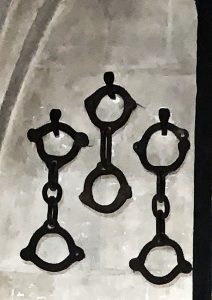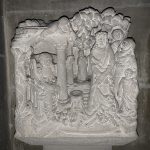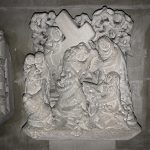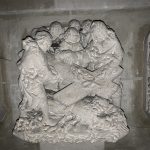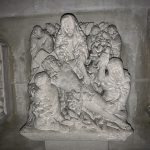About the history and construction of the church St. Lubentius in Dietkirchen is already commented in detail in the menu item “Information about Dietkirchen -> History of the village Dietkirchen”.
This page now shows information about the design and the interior of the church with figures, epithaphs and other details that can still be seen today.
We will make a tour through the church and start with our way into the church going to the left.
Holy water basin
On the way through the church, one gets to a holy water basin after only a few steps. It is made of Lahn marble, as is a second basin which you pass on the way out of the church just before the exit door.
Unfortunately, there are no concrete clues as to the time from which these two baptismal fonts date. However, a profound connoisseur of Lahn marble buildings, Willi Wabel, estimates the origin to be the 19th century. He attributes this to the simple design of the base and shaft.
His description of the basin at the north-western pillar where you are now is:
“The basin…has a baptismal font-like bowl with six bosses and a round shaft with a thickening in the lower half, reminiscent of a nodus (knot-like ornamental element) of baroque shafts. The name inscription PETTER MEŸ poses a riddle. It could be the stonemason or perhaps the founder. Both would be unusual, however. The spelling of the name indicates a creation in the baroque era.”
(see “Two holy-water basins in the St. Lubentius Church in Dietkirchen”. In: KuLaDig, culture.landscape.digital. URL: https://www.kuladig.de/Objektansicht/KLD-290216 (Retrieved: 24 March 2020)
He describes the second basin, which one passes when leaving the church, as follows:
“At the second basin on the first north-western pillar, the bowl with six bosses made of highly speckled marble with several strongly contrasting shades of colour rests on a slightly conical, columnar shaft. A base plate is missing.”
(see “Two holy-water basins in the St. Lubentius Church in Dietkirchen”. In: KuLaDig, culture.landscape.digital. URL: https://www.kuladig.de/Objektansicht/KLD-290216 (Retrieved: 24 March 2020)
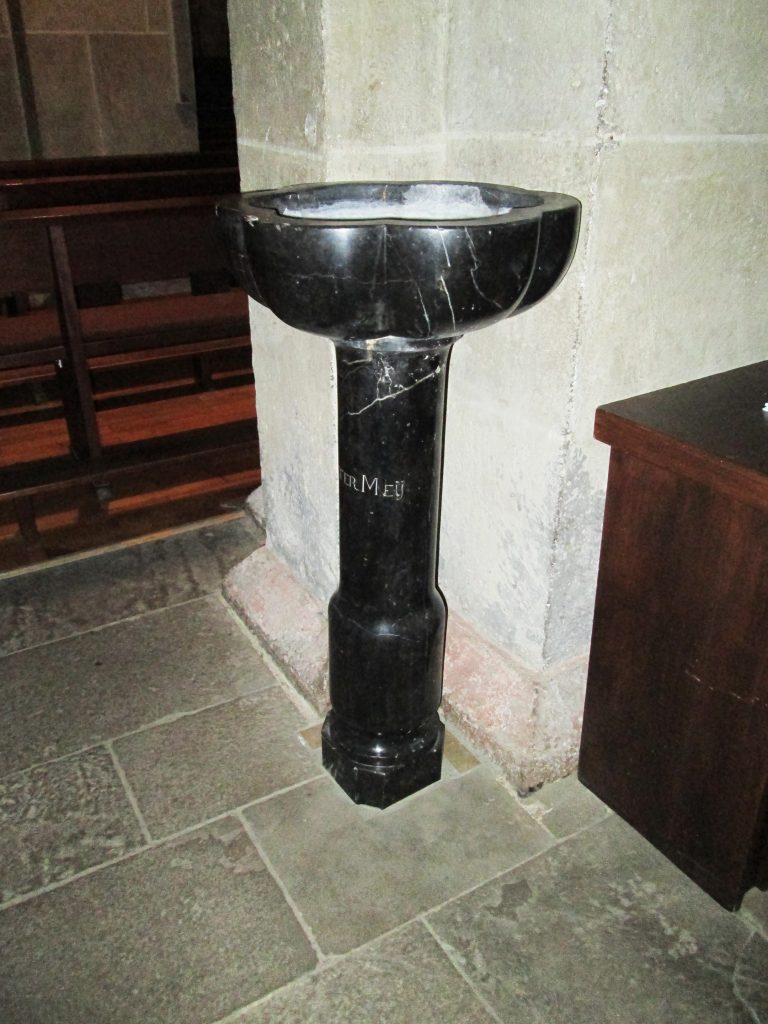


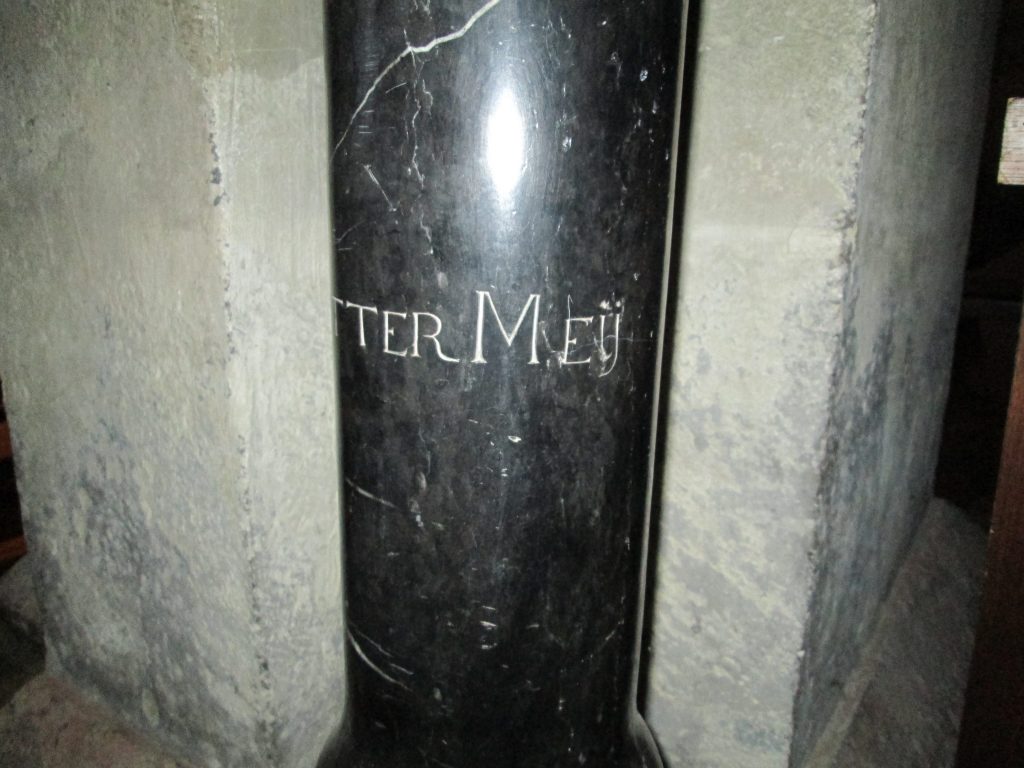
Apostle James
The wooden sculpture depicts the seated apostle James the Elder. According to Struck, the figure dates from the 15th century.
The apostle wears a striking red cloak. His head is clothed in a pilgrim’s hat, on the front brim of which a shell is fixed, the scallop, the sign of St. James. The scallop is only found near Santiago.
In his right hand the apostle holds a book, his left hand seems to float, as if for protection, above a kneeling pilgrim who worships him. Another pilgrim kneels under the book in his right hand.
(see also: Wolf-Heino Struck, Das Stift St. Lubentius in Dietkirchen, 1986)
It is assumed that the figure originally came from one of the early monastery altars.
(see also: Gabriel Hefele, Stift St. Lubentius, Dietkirchen a.d. Lahn, 1995)

Crucifixion Group
If you go a few steps further, you will come to a crucifixion group in the next eastern yoke.
The cross itself did not belong to the group from its origin. The two assistant figures of Mary and John are attributed to the Hadamar sculptor Johann Valentin Neudecker the Elder, who carved these very high-quality figures in 1699 for the choir screen at the triumphal arch.
The colouring is said to date from the 20th century.
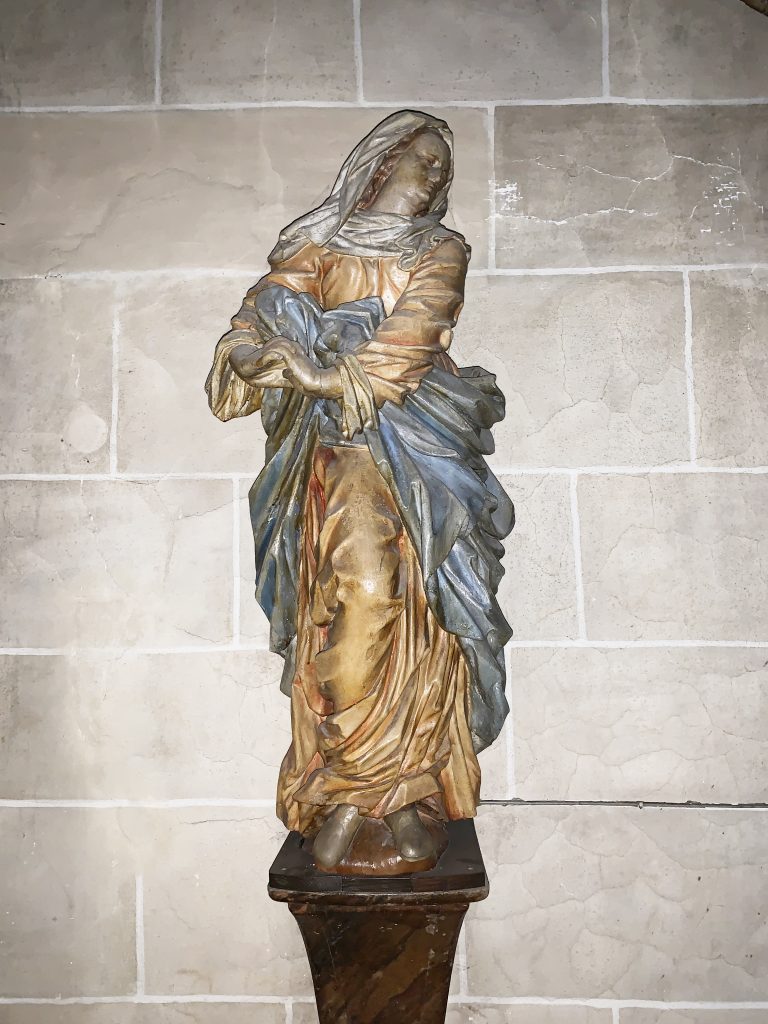
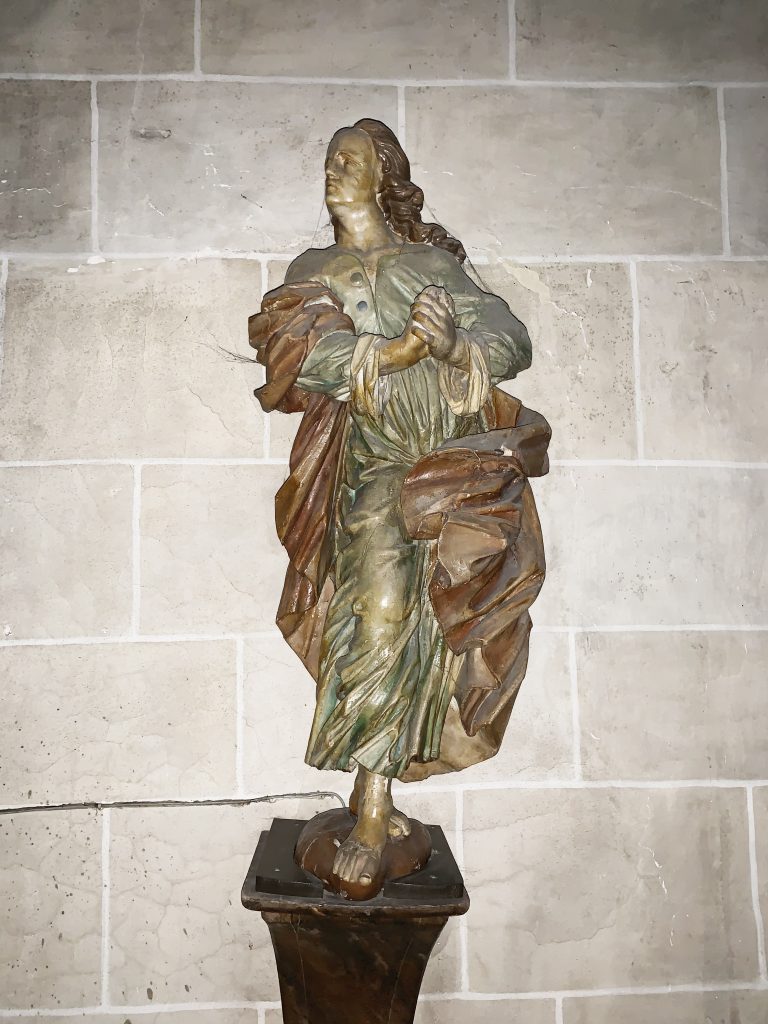

Epitaph for Philipp Frey von Dehrn
The path now continues to the next sight, which is located in the northern aisle.
This is an elaborately designed epitaph from the early Renaissance, which shows the tomb of Philip Frey von Dehrn. It is considered the most beautiful and elaborate epitaph from this period in the region. Luthmer already wrote in his work “Die Bau- und Kunstdenkmäler des Regierungsbezirkes Wiesbaden, VI. Volume I to V and Gesamtregister, 1921”, that “…the tomb can be counted among the most beautiful Renaissance sculptures of our region, both in the monumental posture of the almost life-size figure, whose expressive head suggests a portrait-like quality, and in the rich and masterly balanced construction. The putti of the pedestal holding an inscription plate with fluttering ribbons are reminiscent of Italian models …”.
The inscription on the pedestal reads:
Origin:
ALS MAN ZÄLT NACH CHRISTI
VNSERS HERN VND ERLOESERS
GEBVRT 1550 DEN LETZTEN
TAGH DES MONATS OCTOBRIS
IST WEILANT DER EDELL VND
ERNVEST PHILIPS FREIHE VON
DHERN IN GOTT VERSTORBEN
DER SELEN DER ALMECHTICH
GNEDICH SEIN WOLL. AMEN.
Translation:
AS ONE COUNTS THE YEAR 1550
AFTER CHRISTI OUR LORD AND SAVIOR’S BIRTH THE LAST
DAY OF THE MONTH OCTOBRIS
IS THE NOBLEMAN AND
ERNVEST PHILIPS FREE FROM
DHERN DIED IN GOD.
HIS SOUL THE ALMIGHTY LORD
WANT TO BE MERCY. AMEN.
The epitaph shows Philipp Frey von Dehrn, who died on 31.10.1550 and was married to Anna von Eltz. They had several children, the sons Johann († 5.10.1568), Georg († 28.12.1605), Philipp (1531 – † 23.3.1568) and Wilhelm († 12.3.1595), and the daughters Elisabeth († 1.12.1588), Katharina († 13.1.1571), Kunigunde († 26.5.1611), Dorothea († 22.4.1618) and Margaretha († 1564). The Frey von Dehrn had their burial in the collegiate church.
(See also: http://www.welt-der-wappen.de/Heraldik/aktuell/galerien3/galerie2159.htm).
The deceased is clothed in a suit of armour, he stands between 2 columns on which a curved arch is placed. The hands are folded in front of the chest to pray, the gaze goes directly to the viewer. The helmet lies between the feet of the deceased. Sword and dagger are tied around the body with a belt.
In the four corners are the coats of arms of the family.
In the upper left corner is the coat of arms of Frey von Dehrn, it stands for Johann Frey von Dehrn, the father of the deceased, as well as for the grandfather, who was also called Johann Frey von Dehrn.
On the upper right is the coat of arms of the von Lindau family. This coat of arms stands for the mother of the deceased Anna von Lindau, as well as for the grandfather on his mother’s side, Philipp von Lindau.
On the lower left is the coat of arms of the von Dorfelden family. The coat of arms marks Margret von Dorfelden, the grandmother on father’s side. Margret von Dorfelden was the wife of Johann Frey von Dehrn.
On the lower right is the coat of arms of von Hoen Weisel (Hohenweisel). It stands for the wife of Philipp von Lindau, Lisa von Hohenweisel, the grandmother on mother’s side.
On the semicircular gable of the epitaph the coat of arms of Frey von Dehrn can be seen once again.
Philipp von Dehrn had taken part in the Tunis Campaign under Charles V of Habsburg (Emperor from 1519-1556) and was taken prisoner. The fetters are seen in connection with this imprisonment.
(see also http://www.dehrn.net/geschichte/vii-sagen-und-erzahlungen/1-die-sage-von-ritter-ditrich-von-dern.html – retrieved 26.03.2020)


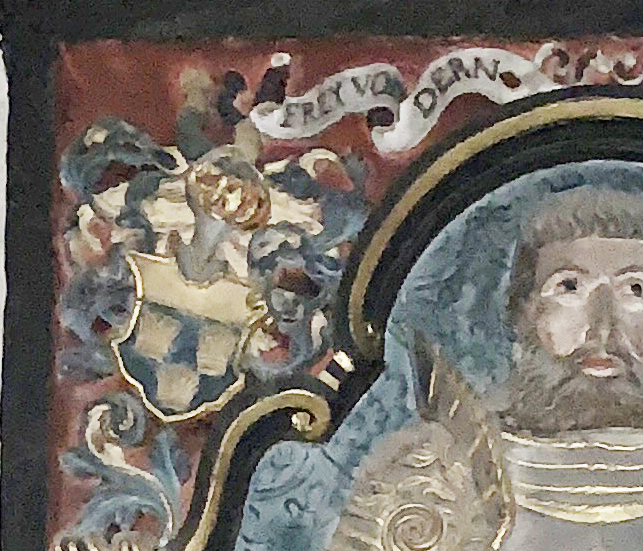



Altar of Virgin Mary
The path continues to the northern apse of the transept.
Here you will find the altar of Mary, donated by the Distel brothers, made of Lahn marble.
However, the founders themselves did not live to see the completion of the altar. The canon Johann Distel died on 6th/7th November 1755, his brother, the dean and canon Heinrich Distel died already in 1740.
Due to the year of its construction it is assumed that the altar was made by a stonemason/sculptor from Villmar or Limburg. The creator of the statue of the Virgin Mary in the altar is also not known.
The altar is mainly made of red Villmar marble, the horizontal black marble elements seem to serve to visually structure and loosen up the altar design. In the niche of the altar structure there is a statue of the Virgin Mary on a globe, carrying the Christ Child on her left arm. A shell forms the top of the niche. The top end of the altar is made of wood and bears a monogram of the Virgin Mary in the middle.
The following inscription can be read on the altar:
AD MAIORIS DEI GLORIAM/ HUIUS ECCL(ES)IAE DECANUS
HENRICUS DISTELL ET SENIOR CAP(ITU)L(AR)IS/IOHANNES
DISTELL FRATRES POSUERE 1758.
Translation:
In 1758, for the greater glory of God and this church, the brothers Heinrich, Dean of this church, and Johannes Distell, Seniorkapitular built this (this altar).
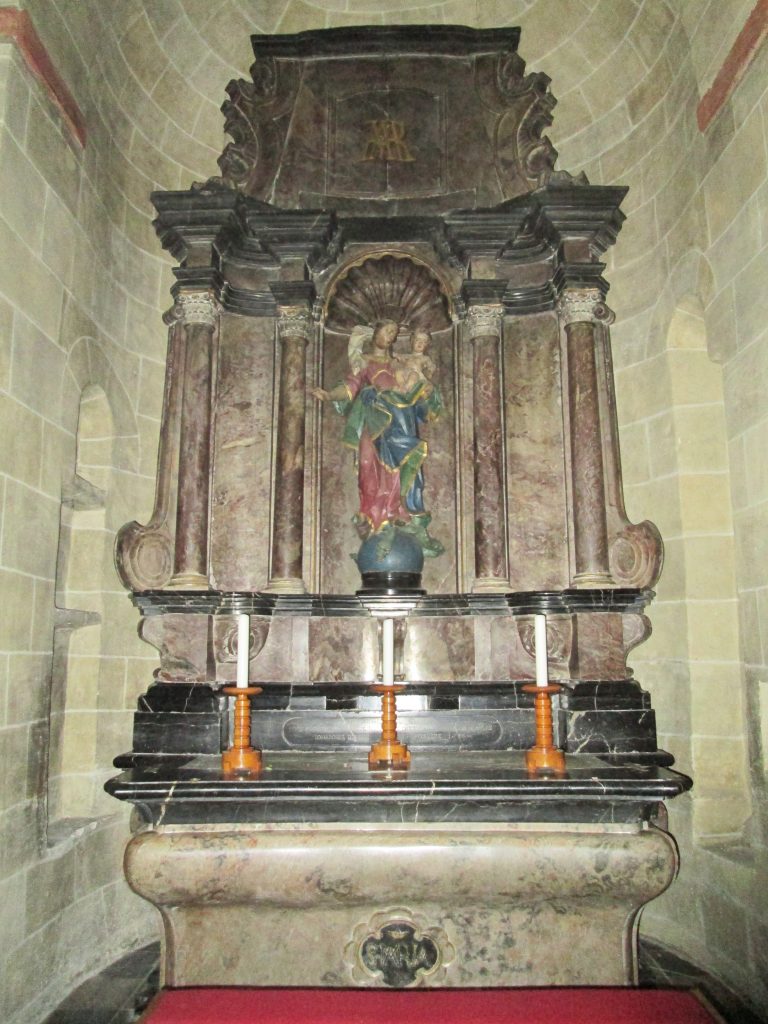
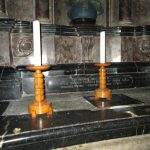
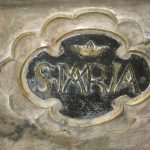
Chancel
The chancel was redesigned in the 1970s. The altar and the ambo were made of sandstone in 1978. The old altar from the 1950s was reused for the altar by reworking. The ambo was also redesigned out of a predecessor. The sacrament house was also newly made of sandstone. It was built in 1981. Main altar and ambo were created by Hein Gernot, Cologne in 1977/78.
In the 195o’s the interior of the church was restored in colour according to the original paintings of the Romanesque period. During the works between 1956-1958 the old colour schemes were discovered, which had shown a squaring with light grey joints on a brownish-grey background. This colour scheme was adopted for the entire room during these years.


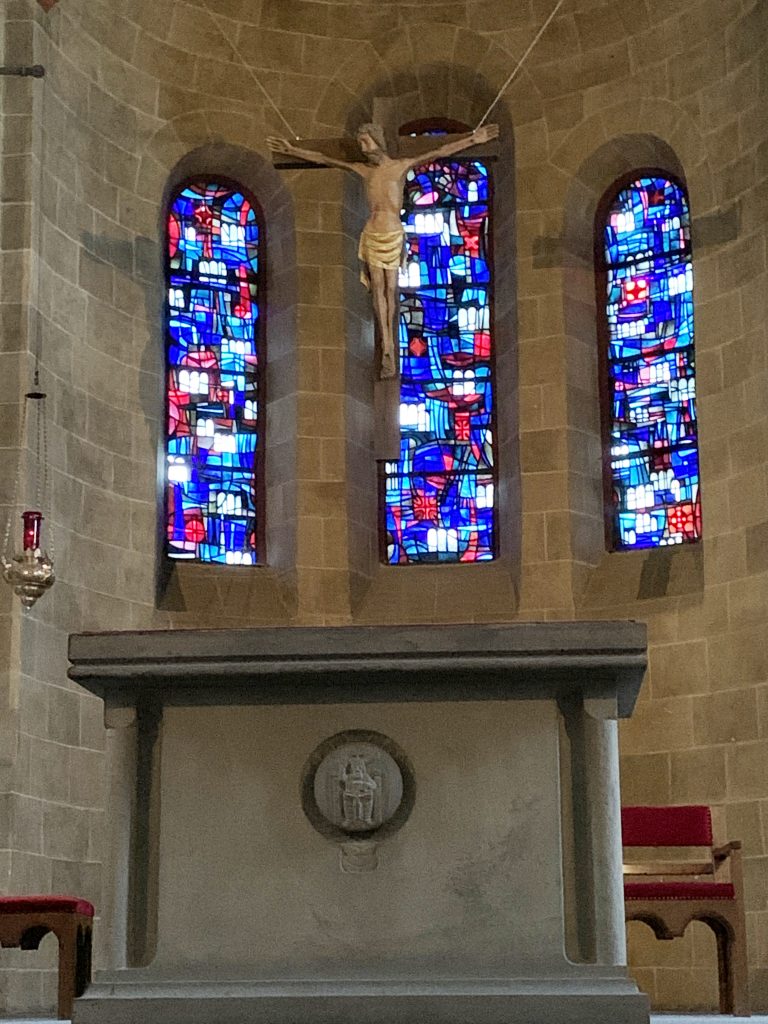
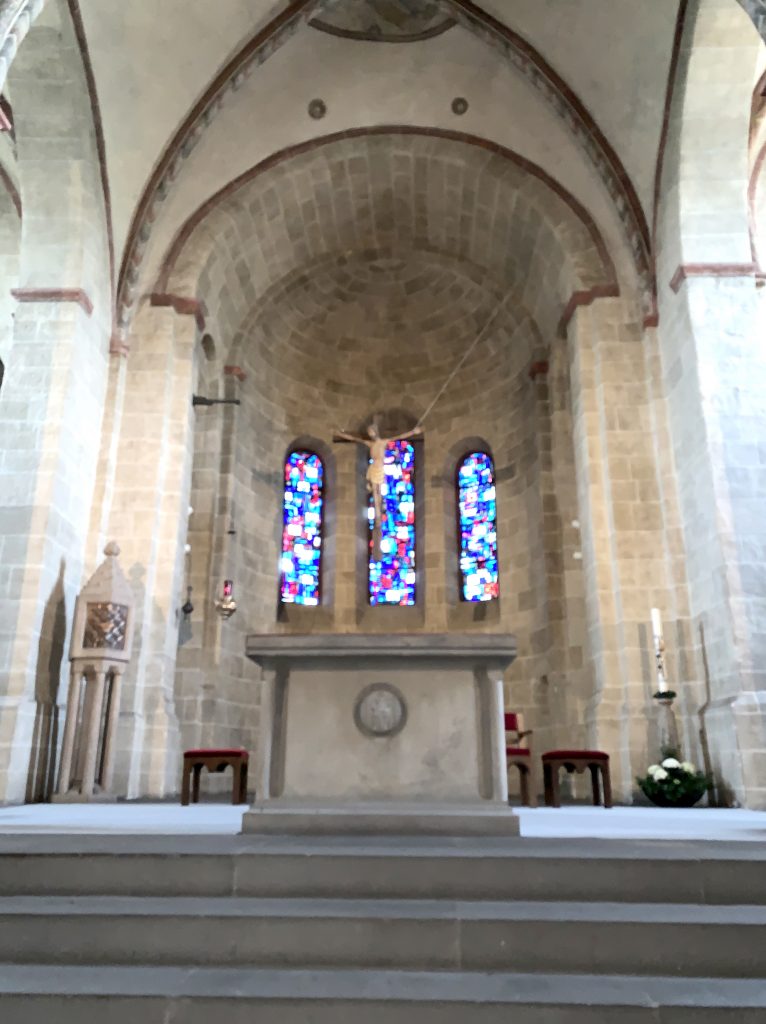
The 3 windows in the central apse, which appear in predominantly blue tones, were installed during the renovations of the 1950s.
The design is by Ferdinand Lammayer from Frankfurt, the execution was carried out by the company Hans Bernd Gossel from Frankfurt.


Ceiling and crossing of the vault ribs
The central nave ceiling is made of wood and is painted with a crossed wave band pattern in light grey/blue and white/red. It was uncovered during the restoration work in 1955-1958 and, according to Struck, its age probably dates back to 1593.
At the intersection of the crossing vault two frescoes can be seen, similar in form to those found in Limburg Cathedral but the Limburg ones are of much better quality. Experts therefore do not assume that the same artist painted these frescoes. Unfortunately the state of preservation is not very good
In each of the frescoes there are 2 men holding large jugs from which water flows. In the other quarters of the frescoes there are indefinable plants.
The men with the jugs symbolize the four paradise rivers Phison, Geon, Tigris and Euphrates. The rivers in turn symbolise the four evangelists who spread the message of Christ in the world.

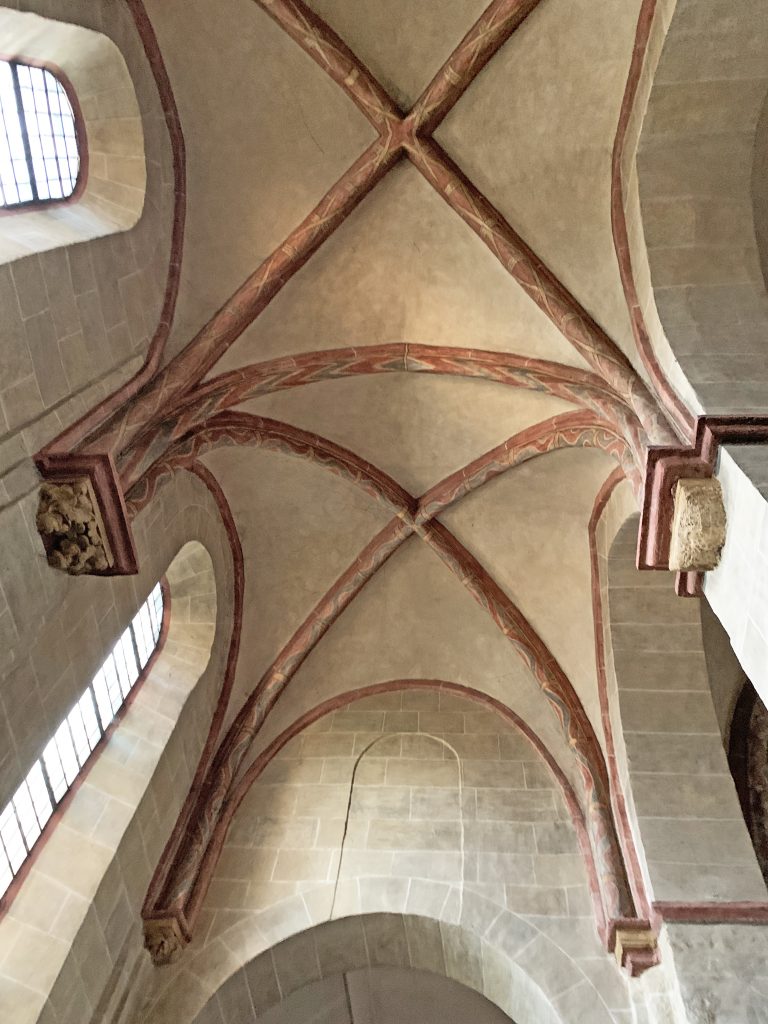
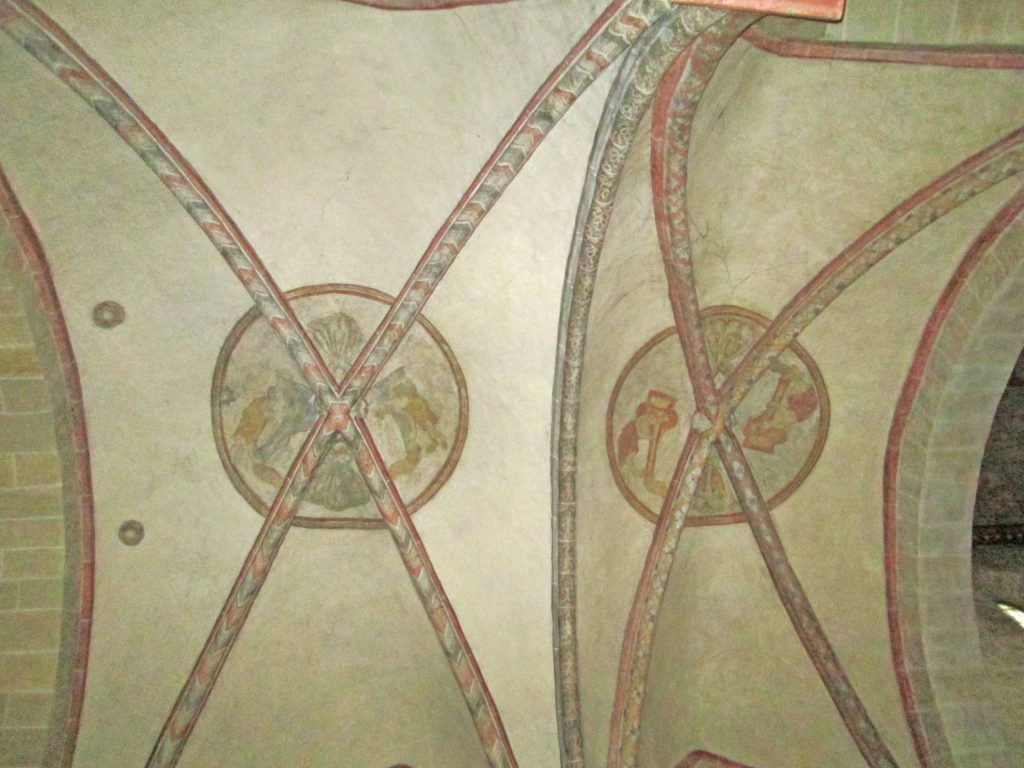

Altar of St. Peter
The path continues to the southern apse of the transept. Here, on the east wall, there is an altar dedicated to the Apostle Peter, which is dated somewhat later than the similarly constructed altar of Mary.
The altar is also made of red Villmar marble, here too the individual levels are horizontally separated by black marble.
The Holy Apostle Peter is framed by 2 columns. In his right hand Peter holds 2 heaven keys. The niche in which he stands is closed at the top by a shell.
According to Willi Wabel (https://www.kuladig.de/Objektansicht/KLD-290193 – retrieved 26.03.2020), the uppermost structure of the altar, also called the extract, is made of wood and shows the apostle Paul, who presents sword and book on a cloud bank.
On the front side of the altar, in a very bright area in the middle, there is a black coat of arms showing the apostle attributes cross, mitre and key.
The year 1760 is to be seen as the date of construction, since according to Struck, this date appears in the inscription, which is laid out as a chronogram.
(see also: Wolf-Heino Struck, Das Stift St. Lubentius in Dietkirchen, 1986, p. 16)
The inscription reads:
HOC ALTARE PETRINO PATRONALE PROPRIo AERE
CVRABAT/JO(HANN)ES CAROLVs KLEIN CANONICo CAPITVLARIs DECANVS/ ET PASTOR LoCI LVXENBVRGENSE WILzENsIs.
Translation:
This altar of St. Peter’s patron saint was donated from his own fortune by Johannes Karl Klein, capitular canon, dean and local priest from Wiltz in Luxembourg.
The decoded chronogram reads:
HOC ALTARE PETRINO PATRONALE PROPRIo AERE
CVRABAT/JO(HANN)ES CAROLVs KLEIN CANONICo CAPITVLARIs DECANVS/
ET PASTOR LoCI LVXENBVRGENSE WILzENsIs.
100 (C) + 50 (L) + 1 (I) + 50 (L) + 1 (I) + 100 (C) + 5 (V) + 1 (I) + 100 (C) + 50 (L) + 5 (V) + 50 (L) + 1 (I) + 100 (C) + 1 (I) + 100 (C) + 100 (C) + 1 (I) + 5 (V) + 50 (L) + 1 (I) + 500 (D) + 100 (C) + 5 (V) + 50 (L) + 100 (C) + 1 (I) + 50 (L) + 5 (V) + 10 (X) + 5 (V) + 5 (V) + 5 (V) + 1 (I) + 50 (L) + 1 (I) = 1760
The founder of this altar is therefore Johann Carl Klein from Wiltz in Luxembourg. He was parish priest in Dietkirchen from 1722, cellarist (accountant) in the monastery from 1737 – 1739, and dean from 1741 until his death in 1772. When he died, he was 81 years old.

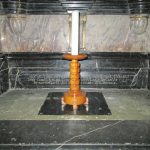

The epitaph of Johann Leonhard Schlüpgen
Johann Leonhard Schlüpgen, also written Schlipgen, came from Wallmerod. He was a son of Anna Ursula Niemaß (?) and H. Laurentius Schlüpgen, the Cuhrfürstlicher trierischer Schultheiß of the parish of Hundsangen. As a widow, Anna Ursula married Hans Joachim Mattheis, tax collector for Baron von Walderdorff. According to an entry in the parish register of Montabaur, he was born in Montabaur on January 8, 1648. He died on 09 Apr 1702.
In Dietkirchen he was dean from 1689-1702. So he was dean for 14 years and capitular for 32 years.
The oval epitaph of black marble hangs on the inner wall of the southern side aisle. It shows his coat of arms at the top: in the shield three flowers on a stem, above the shield a helmet with helmet cover and crest: a growing male figure, in the left a cross, in the right a staff (St. Lubentius?), below the shield the
Inscription:
DESIIT FLOS DUM DECIDIT NARDUS
ABSQUE TAMEN ODORIS OCCASV
DUM
VIVIT POST FUNERA VIRTUAL
ABYT HIC NON OBYT
PL(URI)M(UM) R(EVERENDUS) ET AMP(LUS) D(OMINUS) LEONARDVS HATCH DECANUS CANONICUS ET CAP(ITULARIS) AD S(ANC)T(UM) LUBEN(TIUM)
IN THICK(IRISH)
DII MAN ES POST FATA CORONENT PALE BEADA (instead of: BEATA)
CAETERUM AD ARAS VSQUE ET CINERES PEREN(N)O
ANNO 1702 IPSO PAL(MARUM) THE OBYT
IN S(ANC)T(A) PACE.

Epitaph for the postmaster Emmerich Friedrich de Fabre
Directly to the right of the epitaph of Johann Leonhard Schlüpgen is the epitaph of the postmaster Emmerich Friedrich de Fabre from 1719.
It is made of black and reddish brown Lahn marble, probably from Schupbach and Villmar. The figures, the flame vase and the coat of arms in the upper part of the epitaph are made of alabaster.
In the middle of the pediment there is a Justitia figure between two flame vases.
The coat of arms shows a three-armed cross on a shield. The crossbars are all the same length.
Unfortunately, the author of this article could not find a clear interpretation of this very rare cross form in his research so far.).
The central figure, which is supposed to represent the founder of the epitaph, kneels before a cross with the Saviour. The cross made of black marble stands on a round, reddish-brown marble pedestal. In the upper section, the pedestal is provided with various profiles.
The founder of the epitaph Emmerich Friedrich was a brother of the postmaster Johann Faber junior. According to Willi Wabel (see https://www.kuladig.de/Objektansicht/KLD-290218 – retrieved 26.03.2020), he is said to have been an imperial officer and postmaster in Dietkirchen from 1693 until his death in 1728. The inscription confirms his military career, but gives no indication of a position as postmaster in Dietkirchen. Also in the researches of Helmut Herborn, (see Hessische Postgeschichte Heft 34/1989, pp. 73-75) and the researches of Marie Luise Crone (see Dietkirchen, Geschichte eines Dorfes im Schatten des St. Lubentiusstifts, 1991, pp. 134-137), there are solemn references to an activity of Emmerich Friedrich de Fabre as postmaster.
Since Emmerich Friedrich de Fabre himself donated the epitaph for the deceased and those of his family who will die in the future, the date is certainly not to be seen as the time of death. Emmerich Friedrich was born on 23.11.1670 (Marie Luise Crone, Dietkirchen, Geschichte eines Dorfes im Schatten des St. Lubentiusstifts, 1991, p. 138)
Inscription on the epitaph for the postmaster (?) Emmerich Friedrich de Fabre in the Lubentiuskirche in Dietkirchen:
AD
PIAM MEMORIAM FAMILIAE SUAE DEFUNCTORUM
AC DEFUNCTURORUM POSUIT
HOC
EMERICUS FRIDERICUS DE
FABRE SACRAE CAESAREAE ET
CATHOLICAE MAIESTATIS IN
TERTIUM ANNUM GENERALIS
VIGILIARIUM CAMPI PRAEFECTUS
ET UNIUS REGIMINIS NATIONIS
NEAPOLITANAE PER TREDECIM
ANNOS COLONELLUS
1719
Translation of the inscription:
In reverent memory of the deceased and future deceased of his family, Emmerich Friedrich de Fabre, in his third year as Prefect General of the Field Guards for the Imperial and Catholic Majesty and for thirteen years as Colonel of the only government of the Neapolitan nation, erected this (monument). 1719.
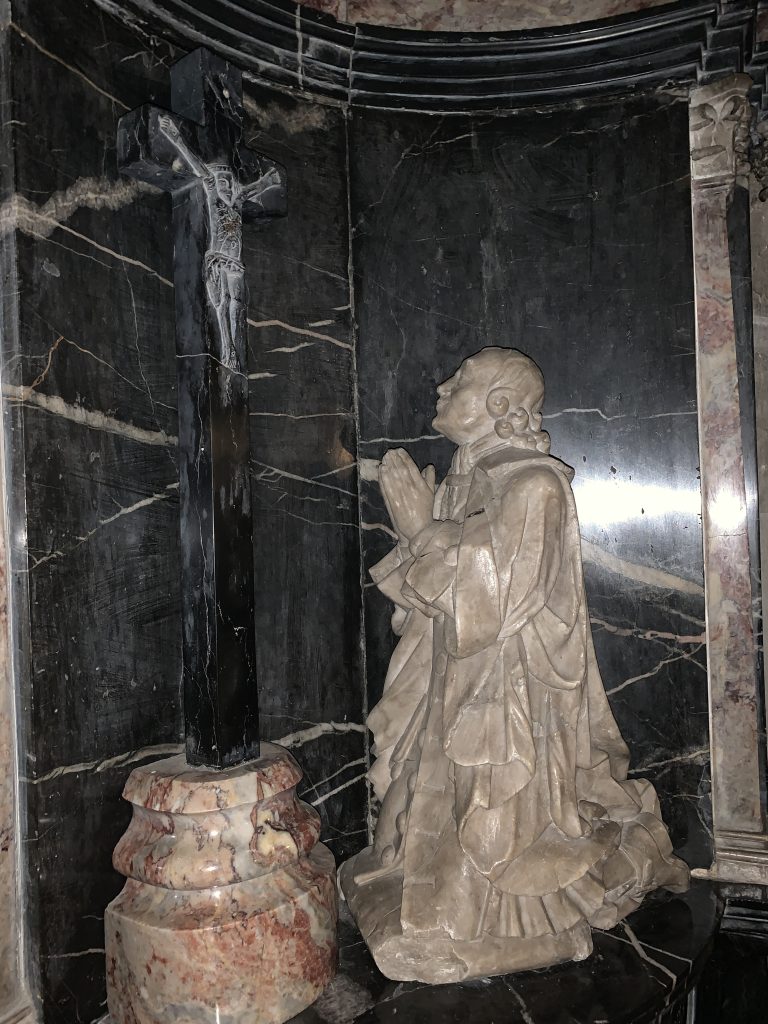

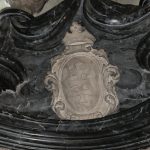


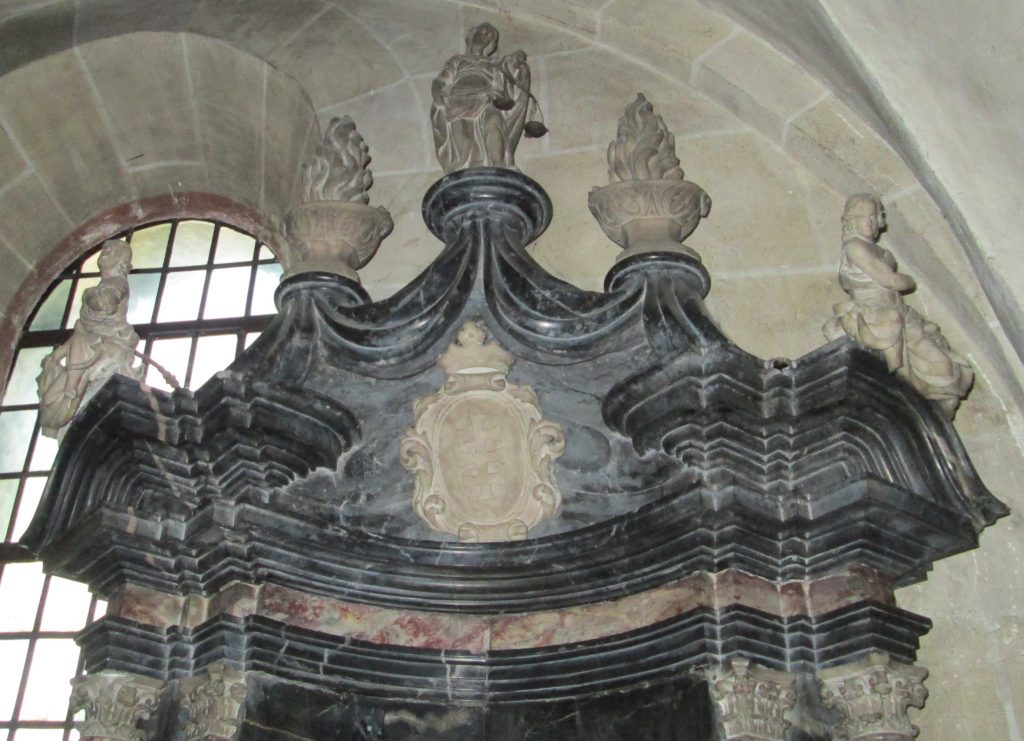
Stations of the Cross
Only a few steps further, in the now following yoke, 8 Stations of the Cross are mounted on the wall. They were made of French limestone as a contemporary work by the Villmar stonemason Walter Schmitt of the company Eng. Müller/Höhler in 1973/1974. He designed and executed the stations.
They were installed on August 16, 1981 (Gabriel Hefele in: Die künstlerische und liturgische Ausstattung der Pfarrkirche St. Lubentius Limburg-Dietkirchen, publisher Bischöfliches Ordinariat Limburg, editor Gabriel Hefele).
The consoles were designed by Wilhelm Jungherz.
When these stations were installed in the church, these sculptures provoked very contradictory opinions in the congregation.
The view of the stations is to be read from east to west, that is, from left to right.
All picture descriptions are taken from:
Gabriel Hefele, Die künstlerische und liturgische Ausstattung der Pfarrkirche St. Lubentius Limburg-Dietkirchen, publisher Bischöfliches Ordinariat Limburg.
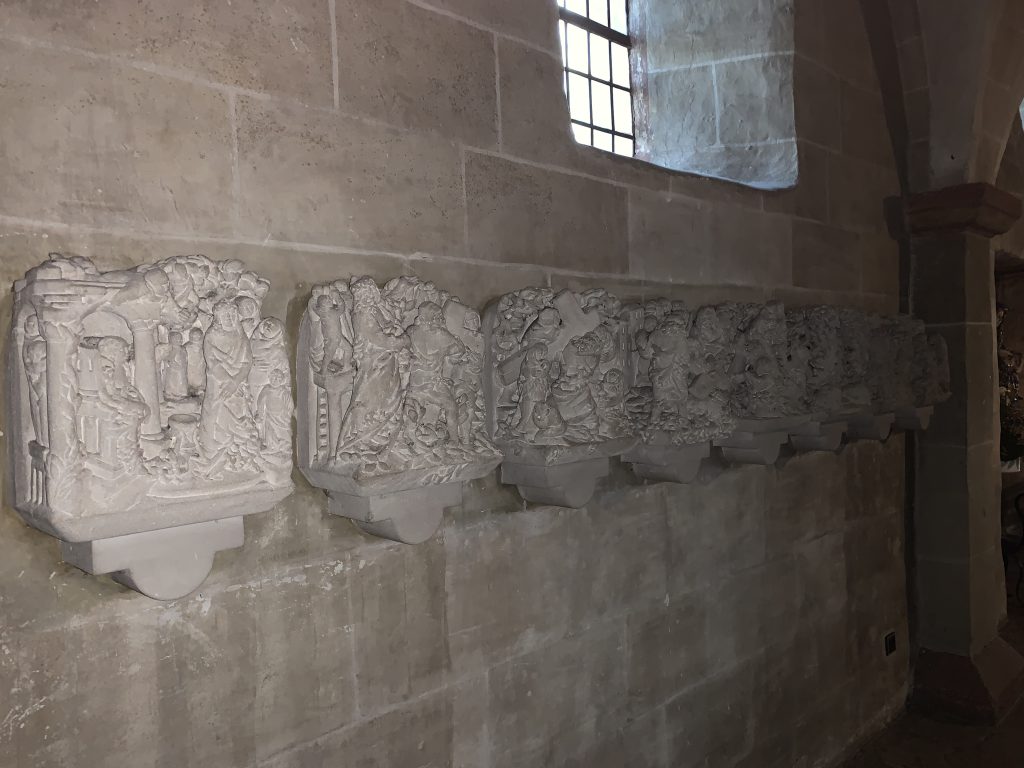
Station 1 (Jesus in fron of Pilate)
In an open portico, Pilate sits on a throne on the left. In front of him on the right, Jesus stands dominating the picture, his hands crossed in front of his body. Pilate points with a large gesture to the hand basin standing between them. The right edge of the picture is bordered by mourning attendants. The space above is occupied by trees. Also on the left behind the seated governor – poorly visible from the front – are two mourners. On the roof of the loggia a reclining figure can be identified, which turns with a threatening gesture in the direction of the condemned to death.
Station 2 (Laying on of the cross)
At the left edge of the picture Jesus can be seen striding out and gesticulating. On the right side in front of him two henchmen are busy to put up the cross. In the entire background of the picture, from an elevated and distant position, gawking people curiously observe the events.
Station 3 (Carrying the cross)
Positioned in front in the center of the picture, Jesus, striding out to the right and in a bent posture, carries the conspicuously large cross on his left shoulder. Positioned in the left depth of the picture, Simon of Cyrene helps to carry the cross by grasping the trunk of the cross with both hands. At the right edge of the picture, the kneeling Veronica hands Jesus the face-cloth. Meanwhile, behind her, Mary, bowed in compassion, has laid her hand on the cross. Other mourning women border the scene to the left. The entire scene is covered by wild tendrils.
Station 4 (Jesus falls under the cross)
Under the weight of the cross, Jesus has fallen to the ground to the right. On the left, Simon of Cyrene supports the cross. Opposite him in the middle ground, a man is trying to stop the henchman on the right from using the scourge and torture rope against Jesus. In the center of the picture’s background are three more henchmen. They are accompanied by architecture that locates the action outside the gates of the city of Jerusalem. The formal balance and tense composition of the scene particularly emphasizes the cross leading from the depth of the picture.
Station 5 (Jesus is nailed to the cross)
The diagonal position of the cross determines the structure of the relief. In the center of the picture, Mary has grasped the arm of her son. Lying and largely uncovered, he is being nailed to the cross by two kneeling henchmen flanking the picture.
On the right in the background two soldiers divide the clothes of Jesus among themselves. On the left in the background of the picture, the favorite disciple John takes care of Jesus’ mother.
Station 6 (Jesus dies on the cross)
A densely overgrown arbor frames the crucifixion scene above and to the side. Below it, the two assistant figures Mary and John flank the centered, formally not fully formed cross, praying and mourning. With his arms spread wide, Jesus has died on the cross. The viewer experiences Jesus Christ above all as majesty in his majestic dignity. From the front, central steps lead to the cross, thus demonstratively to salvation. As the cross widely hides the cavity behind it, it points to the supposed burial cave. The death of Jesus Christ is illustrated in the foreground of the picture to the left and right of the steps by two crouching, kneeling women.
Station 7 (Lamentation of Jesus Christ)
On Golgotha, Mary weeps for her dead son taken down from the cross. In the raised background of the picture, she is holding the body of Jesus Christ with both arms.
To the right, three empty crosses clearly refer to the past events.
In the center of the foreground at the foot of the rock Mary Magdalene has sunk to her knees. Further mourners are located on the left and right edges of the picture.
Station 8 (Entombment of Jesus Christ)
In the foreground of the picture, two persons wrap the body of Jesus Christ in cloths, according to the custom of the Jews. The scene is framed by a rocky, partly overgrown background with a round-arched entrance to the burial cave. On the left side of the rock, in small format and with raised arms, the risen Christ is already depicted. Two people stand searching in front of the empty burial chamber. On the right on the hill three crosses – now as a sign of victory over death – remind of the Passion.
Pieta
On the way further you will now come to a Pieta figure.
In the visual arts, a Pieta is the representation of Mary as Mater Dolorosa (Mother of Sorrows) with the body of Jesus Christ taken down from the cross. With the Pieta, in contrast to the Lamentation of Christ, the body of Jesus always lies in Mary’s lap.
The Pieta in Dietkirchen, which in literature is also referred to as the picture of Vespers, because at the time of Vespers, the monastic prayer in the afternoon, the body of Christ was taken down from the cross, shows Our Lady in a cobalt blue cloak with a golden border. The cloak also covers the head.
The body of Jesus lying in her lap is rather small in proportions. The side wound is shown on the right, although the lance thrust was certainly made into the left side of the body. The Roman soldiers had tried to convince themselves of the death of a crucified man by stabbing the side with a lance.
The figure is made of wood and dates from the beginning of the 15th century.

Entrance lattice to the organ gallery
Continuing on, one now comes to the staircase to the south gallery, after passing the exit door to the southern exterior of the church.
At the entrance to the organ loft you will come across a grille which keeps the entrance closed outside of church services.
At first sight, the grille seems to be medieval, but at the second glance it gives elements of modern influence to recognize.
The design for this lattice was created in 1980 by the Cologne/Limburg architect Wilhelm Jungherz. The execution was probably carried out by the Sommer company in Elz.
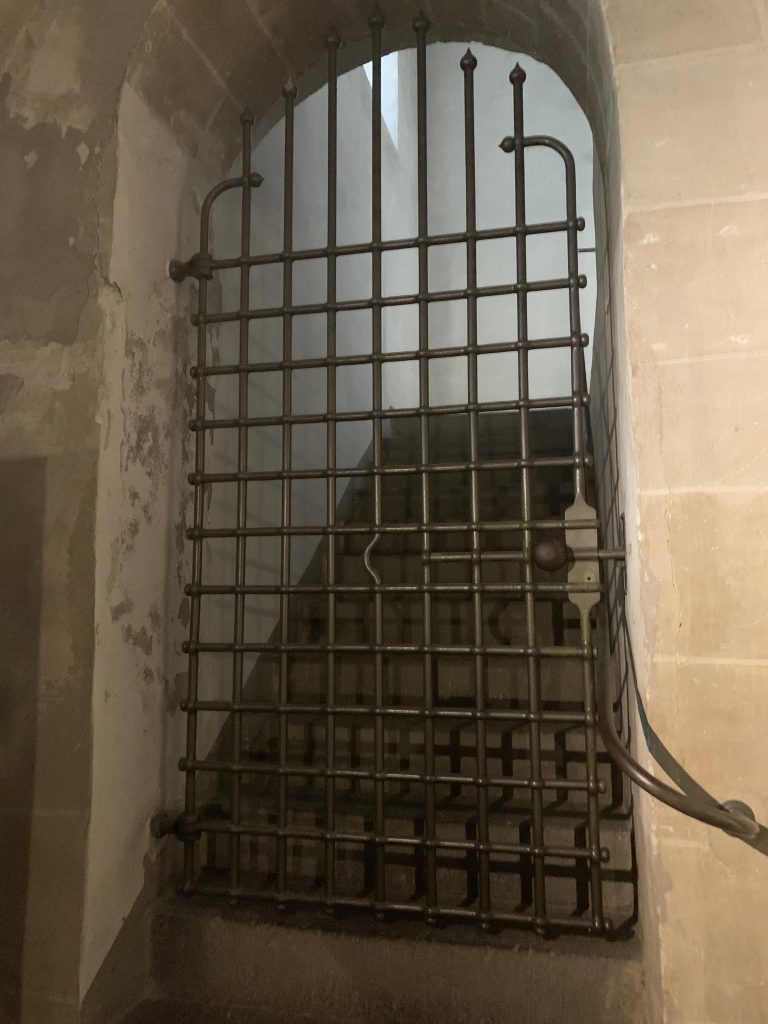
Commemorative plaque papal bell
To the right of the staircase there is a plaque on the wall commemorating the visit of Pope John Paul II to Germany and the foundation and consecration of the papal bell.
The inscription reads:
In constant remembrance of the visit
of Pope John Paul II in Germany
is located in the large tower of this church
the Pope’s bell, which on 31 October 1980
in presence of H.E. Archbishop Verolino,
Vatican, was poured in Gescher.
By the Holy Father on November 17, 1980
consecrated in Fulda, arrived by ship on the 19th.
November 1980 in Dietkirchen and was
warmly welcomed by the parish.
On 23 November 1980, in thanks for the
successful papal journey and the arrival of the
Pope’s bell, a pontifical service was held at which
high dignitaries from the Vatican attended.
On the first Sunday of Advent, November 30, 1980,
this bell was handed over from the bell donator and
-patron, director Hans-Albert Courtial, to his
home church on behalf of his organization,
Courtial journeys, on the occasion of the 100,000 Rompilgers
in honour of St. Lubentius to Pastor Hartmann.
On the same day her bell rang out
for the first time. May her ringing be a blessing for all time
for the country and its people.
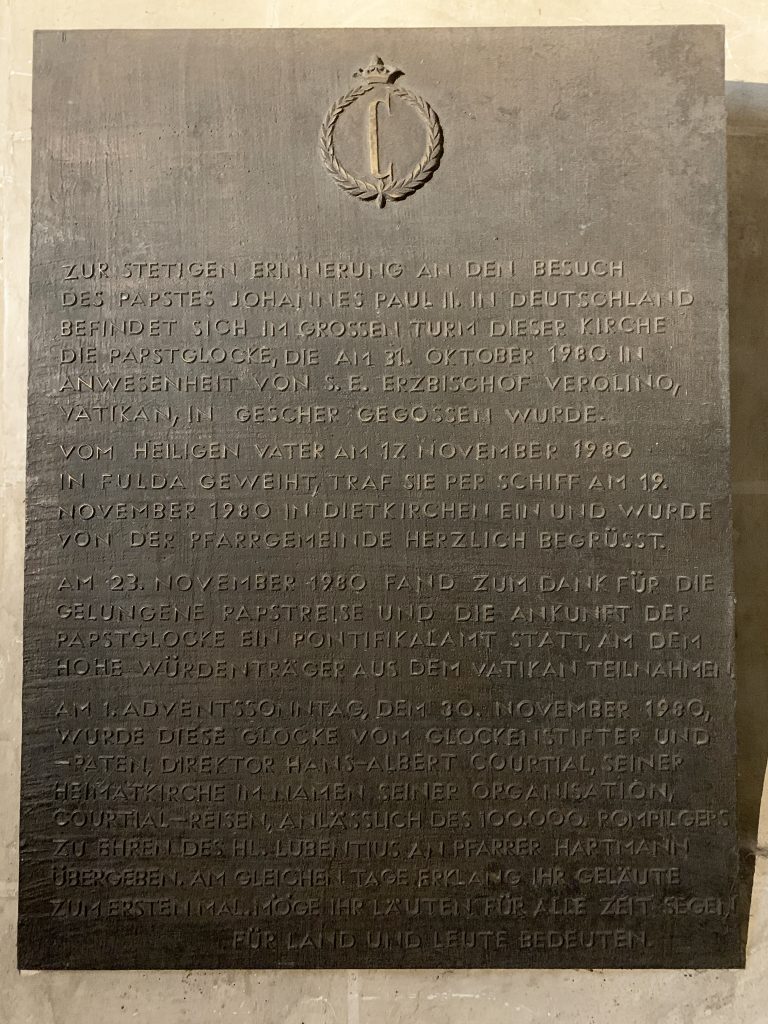
Mary Immaculate
Directly to the right of the memorial plaque is a figure of the Virgin Mary, a Maria Immaculata, the Immaculate Mary.
Mary has folded her hands to pray, her blond hair is not covered. A blue cape covers her figure, which is dressed in a white undergarment. The cloak is decorated with a golden braid. The figure stands on the globe, symbolized by the blue ball and the crescent moon. With her right foot she crushes the head of a snake, which holds an apple in its mouth.
The snake, which winds around the globe, represents original sin and thus all evil. The apple symbolizes the fall of Adam.
The trampling of the snake’s head symbolises the overcoming of original sin by Mary.
Gabriel Hefele dates the figure to 1905.
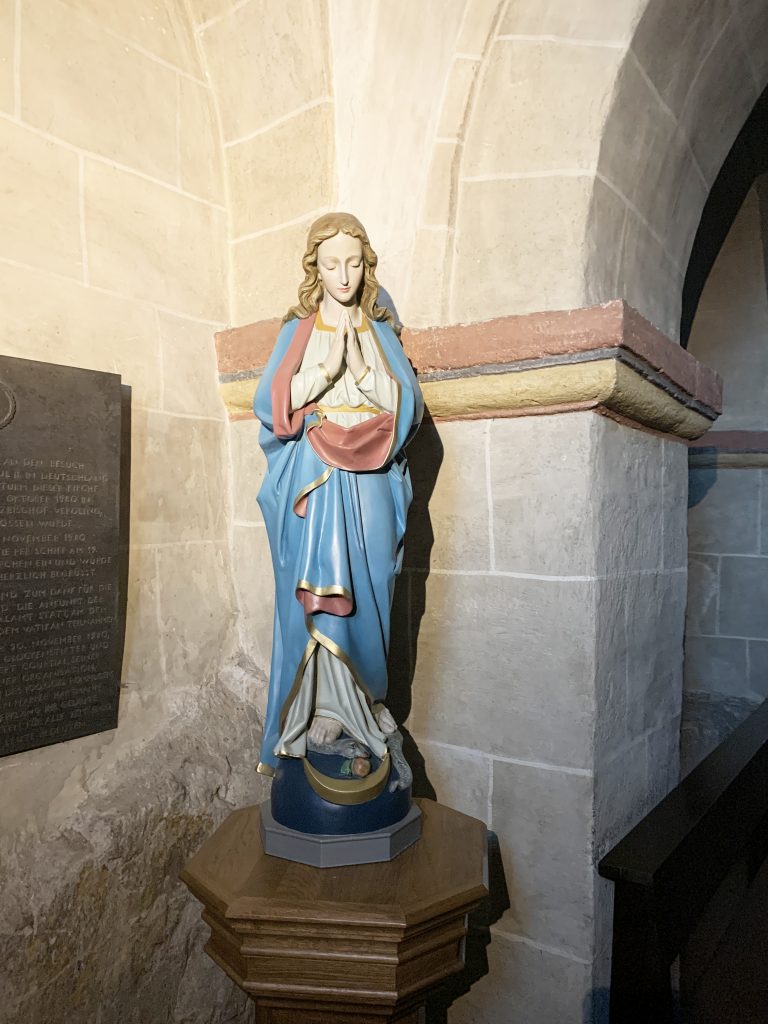
Michael vanquishes the devil
In the next but one yoke to the right of the statue of the Virgin Mary, you come across a portrait showing the archangel Michael defeating the devil.
According to Gabriel Hefele, the painting was created in the middle of the 18th century.
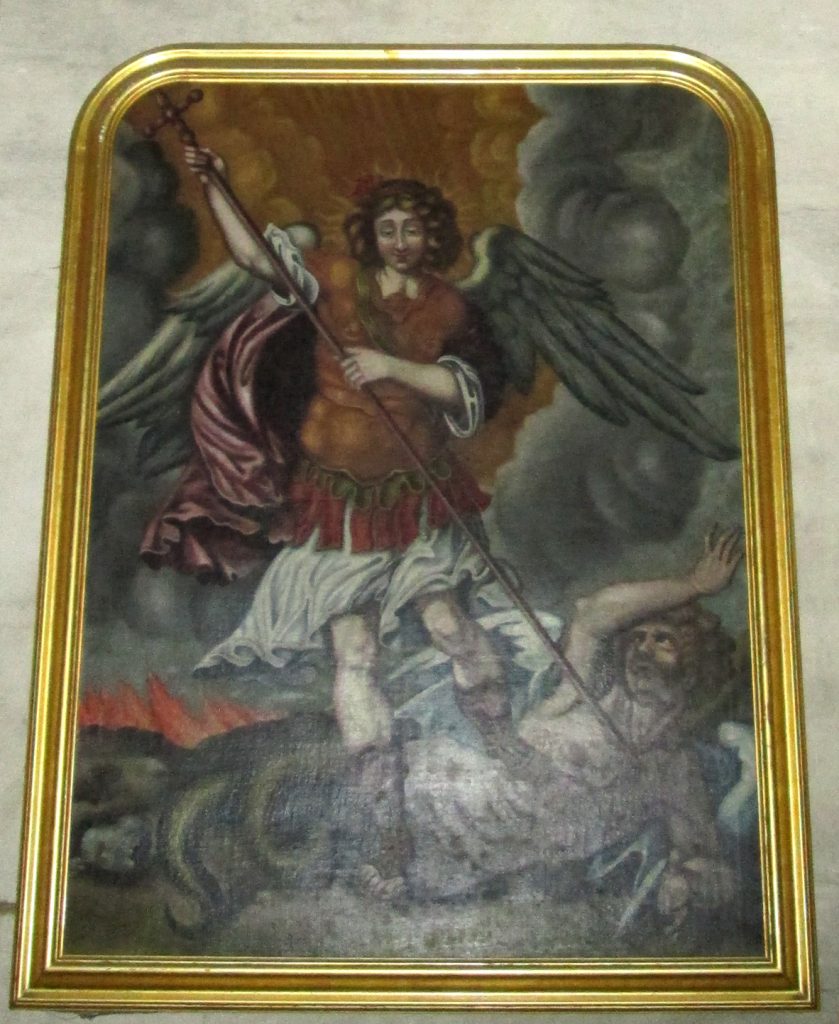
Baptismal font
Before you visit the Lubentius Chapel on your way out, take a look at the baptismal font.
The hemispherical, late Romanesque basin with a notch-like frieze is estimated by art experts to date back to the 13th century.
The basin rests on a short central pillar made of lighter stone. In contrast to the massive appearance of the basin, it is supported on the outside by six very fragile columns with bud capitals. The bases of the columns are each Attic.
The basin is 0.85 m high. It has a diameter of 0.94 m and a depth of 0.31 m.
The hexagonal wooden structure that closes the basin is attributed to the 17th century, with an origin around 1600.

Lubentius Chapel
The Lubentius Chapel, which is located in the lower part of the north-west tower of the church, was consecrated in August 1975 in a Eucharistic celebration by the Limburg Auxiliary Bishop Walter Kampe in the presence of the Indian Archbishop and later Cardinal Antony Padiyara, District Dean Alois Staudt and several priests from neighbouring parishes. The new altar of the chapel was consecrated on this occasion. Archbishop Padiyara was present on the occasion of the Sunday of World Mission in the Diocese of Limburg.
The altar in the chapel covers the sandstone sarcophagus of St. Lubentius. The altar was created in the mid 70s by the Cologne artist and sculptor Heinz “Hein” Gernot (02.02.1921-12.10.2009).
Gernot wanted to integrate especially architecture and modern elements into historical church rooms, a procedure which is impressively recognizable in the Lubentius Chapel.
The aim in Dietkirchen was to create a liturgical unity of refectory, reliquary and sarcophagus.
The windows of the chapel were designed by the painter, graphic artist and glass artist Johannes Schreiter (* March 8, 1930), the execution was carried out by W. Derix (DERIX GLASSTUDIOS Taunusstein). The windows were created and installed in 1975. The windows are signed as follows:
Entwurf (=DESIGN) J. SCHREITER /
AUSFÜHRUNG (=EXECUTION) W. DERIX
(after the name DERIX you can see the logo of the company, a “W” with a cross over the center of the “W”)
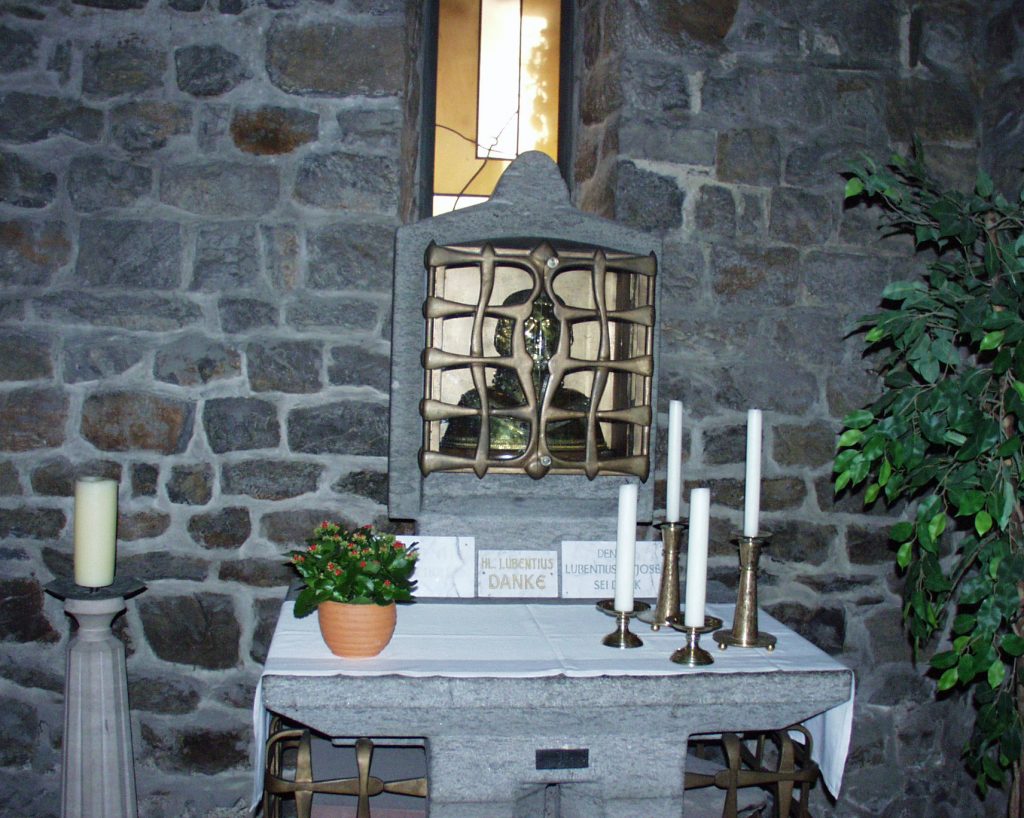

The lattice of the top is in a harmonious relationship with the lattice that encloses the sarcophagus below the altar.
The strikingly small sarcophagus still contains the remains of St. Lubentius. In it his body was transferred from Kobern to Dietkirchen.
Commemorative plaque for the 1500th anniversary of the introduction of Christianity
On the way to the exit, a memorial plaque can be seen somewhat hidden on the wall.
It is made of slightly white veined black Schupbach marble with inset golden lettering.
The dimensions of the plaque are:
H 90.3 cm
W 60.2 cm
The text on the plaque reads:
369 + 1869
Ad sempiternam Dei gloriam
Et perpetuam rei memoriam.
—- + —
In the year of salvation 1869
the parish of Dietkirchen celebrated the
fifteen hundredth anniversary of the
introduction of Christianity
by St. Lubentius in a festive
Octave from 13 to 20 October
— + —-
The two lines
Ad sempiternam Dei gloriam
Et perpetuam rei memoriam.
can be translated as:
To God’s eternal glory
and to the eternal memory.
The stonemason himself added an inscription in the text box at the bottom left: “I Mai. fecit Villmar” (1 May. It was made in Villmar).

Sources:
- “Zwei Weihwasserbecken in der St. Lubentius-Kirche zu Dietkirchen”. In: KuLaDig, Kultur.Landschaft.Digital. URL: https://www.kuladig.de/Objektansicht/KLD-290216 (Retrieved: March 24, 2020)
- Wolf-Heino Struck, Das Stift St. Lubentius in Dietkirchen, 1986
- Luthmer in his work “Die Bau- und Kunstdenkmäler des Regierungsbezirkes Wiesbaden, VI. Volume: Nachlese und Ergänzungen zu den Bänden I bis V und Gesamtregister, 1921
- Bernhard Peter, Galerie: Photos schöner alter Wappen Nr. 2159, Dietkirchen, http://www.welt-der-wappen.de/Heraldik/aktuell/galerien3/galerie2159.htm – retrieved 26.03.2020
- Claus Burggraf, http://www.dehrn.net/geschichte/vii-sagen-und-erzahlungen/1-die-sage-von-ritter-ditrich-von-dern.html – retrieved 26.03.2020
- Willi Wabel, (see https://www.kuladig.de/Objektansicht/KLD-290193 – retrieved 26.03.2020
- Willi Wabel (see https://www.kuladig.de/Objektansicht/KLD-290218 – retrieved 26.03.2020)
- Gabriel Hefele, St. Lubentius, Dietkirchen a.d. Lahn, Schnell, Kunstführer Nr. 2072, 1. Auflage 1999
- Gabriel Hefele, Die künstlerische und liturgische Ausstattung der Pfarrkirche St. Lubentius Limburg-Dietkirchen, Herausgeber Bischöfliches Ordinariat Limburg, Bearbeiter Gabriel Hefele
- Helmut Herborn, (see Hessische Postgeschichte Issue 34/1989, pp. 73-75)
- Marie Luise Crone, Dietkirchen, Geschichte eines Dorfes im Schatten des St. Lubentiusstifts, 1991, pp. 134-138
Pictures:
©Ludwig Ries

